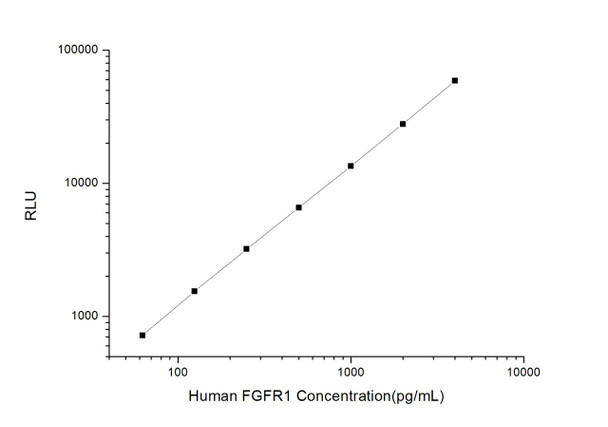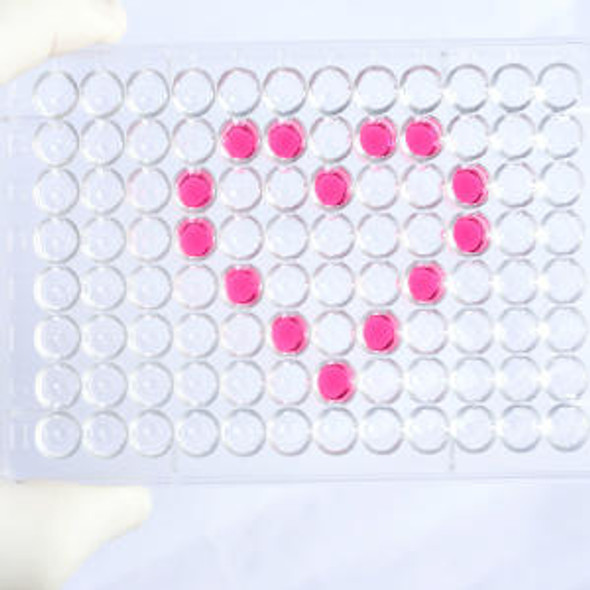Human Epigenetics and Nuclear Signaling ELISA Kits
Human FGFR1 (Fibroblast Growth Factor Receptor 1) CLIA Kit (HUES00245)
- SKU:
- HUES00245
- Product Type:
- ELISA Kit
- ELISA Type:
- CLIA Kit
- Size:
- 96 Assays
- Sensitivity:
- 37.5pg/mL
- Range:
- 62.5-4000pg/mL
- ELISA Type:
- Sandwich
- Synonyms:
- CD331, FLT2, KAL2, CEK, FLG, BFGFR, FGFBR, N-SAM
- Reactivity:
- Human
- Sample Type:
- Serum, plasma and other biological fluids
- Research Area:
- Epigenetics and Nuclear Signaling
Description
| Assay type: | Sandwich |
| Format: | 96T |
| Assay time: | 4.5h |
| Reactivity: | Human |
| Detection method: | Chemiluminescence |
| Detection range: | 62.50-4000 pg/mL |
| Sensitivity: | 37.50 pg/mL |
| Sample volume: | 100µL |
| Sample type: | Serum, plasma and other biological fluids |
| Repeatability: | CV < 15% |
| Specificity: | This kit recognizes Human FGFR1 in samples. No significant cross-reactivity or interference between Human FGFR1 and analogues was observed. |
This kit uses Sandwich-CLIA as the method. The micro CLIA plate provided in this kit has been pre-coated with an antibody specific to Human FGFR1. Standards or samples are added to the appropriate micro CLIA plate wells and combined with the specific antibody. Then a biotinylated detection antibody specific for Human FGFR1 and Avidin-Horseradish Peroxidase (HRP) conjugate are added to each micro plate well successively and incubated. Free components are washed away. The substrate solution is added to each well. Only those wells that contain Human FGFR1, biotinylated detection antibody and Avidin-HRP conjugate will appear fluorescence. The Relative light unit (RLU) value is measured spectrophotometrically by the Chemiluminescence immunoassay analyzer. The RLU value is positively associated with the concentration of Human FGFR1. The concentration of Human FGFR1 in the samples can be calculated by comparing the RLU of the samples to the standard curve.
| UniProt Protein Function: | FGFR1: a receptor tyrosine kinase of the highly-conserved fibroblast growth factor receptor (FGFR). Binds both acidic and basic fibroblast growth factors and is involved in limb induction. Point mutations cause Pfeffer syndrome (finger and toe malformations and other skeletal errors) and dominant Kallmann syndrome 2. Stem cell leukemia lymphoma syndrome (SCLL) may be caused by a t(8;13)(p12;q12) translocation that fuses a zinc finger gene, ZNF198, to FGFR1. Various myeloproliferative disorders have been linked to translocations that fuse FGFR1 to FOP, FIM, CEP1 or the atypical kinase, Bcr. Inhibitor: SU5402. 20 isoforms of the human protein produced by alternative splicing have been described. |
| UniProt Protein Details: | Protein type:Protein kinase, TK; Protein kinase, tyrosine (receptor); Oncoprotein; EC 2. 7. 10. 1; Membrane protein, integral; Kinase, protein; TK group; FGFR family Chromosomal Location of Human Ortholog: 8p11. 23-p11. 22 Cellular Component: integral to plasma membrane; cytoplasmic membrane-bound vesicle; extracellular region; plasma membrane; integral to membrane; nucleus; cytosol; receptor complex Molecular Function:heparin binding; identical protein binding; protein binding; fibroblast growth factor binding; protein homodimerization activity; fibroblast growth factor receptor activity; protein-tyrosine kinase activity; ATP binding Biological Process: paraxial mesoderm development; axon guidance; peptidyl-tyrosine phosphorylation; nerve growth factor receptor signaling pathway; protein amino acid autophosphorylation; cell maturation; neuron migration; negative regulation of transcription from RNA polymerase II promoter; middle ear morphogenesis; protein amino acid phosphorylation; positive regulation of MAP kinase activity; sensory perception of sound; positive regulation of MAPKKK cascade; ureteric bud development; regulation of cell differentiation; induction of an organ; midbrain development; positive regulation of mesenchymal cell proliferation; positive regulation of cell proliferation; chondrocyte differentiation; angiogenesis; skeletal development; embryonic limb morphogenesis; positive regulation of cardiac muscle cell proliferation; epidermal growth factor receptor signaling pathway; inner ear morphogenesis; cell migration; fibroblast growth factor receptor signaling pathway; phosphoinositide-mediated signaling; chordate embryonic development; transcription, DNA-dependent; in utero embryonic development; outer ear morphogenesis; MAPKKK cascade; positive regulation of cell cycle; neuroblast division in the ventricular zone; positive regulation of phosphoinositide 3-kinase cascade; mesenchymal cell differentiation; skeletal morphogenesis; insulin receptor signaling pathway; auditory receptor cell development; innate immune response; positive regulation of neuron differentiation; regulation of lateral mesodermal cell fate specification Disease: Pfeiffer Syndrome; Hypogonadotropic Hypogonadism 2 With Or Without Anosmia; Jackson-weiss Syndrome; Trigonocephaly 1; Osteoglophonic Dysplasia |
| NCBI Summary: | The protein encoded by this gene is a member of the fibroblast growth factor receptor (FGFR) family, where amino acid sequence is highly conserved between members and throughout evolution. FGFR family members differ from one another in their ligand affinities and tissue distribution. A full-length representative protein consists of an extracellular region, composed of three immunoglobulin-like domains, a single hydrophobic membrane-spanning segment and a cytoplasmic tyrosine kinase domain. The extracellular portion of the protein interacts with fibroblast growth factors, setting in motion a cascade of downstream signals, ultimately influencing mitogenesis and differentiation. This particular family member binds both acidic and basic fibroblast growth factors and is involved in limb induction. Mutations in this gene have been associated with Pfeiffer syndrome, Jackson-Weiss syndrome, Antley-Bixler syndrome, osteoglophonic dysplasia, and autosomal dominant Kallmann syndrome 2. Chromosomal aberrations involving this gene are associated with stem cell myeloproliferative disorder and stem cell leukemia lymphoma syndrome. Alternatively spliced variants which encode different protein isoforms have been described; however, not all variants have been fully characterized. [provided by RefSeq, Jul 2008] |
| UniProt Code: | P11362 |
| NCBI GenInfo Identifier: | 120046 |
| NCBI Gene ID: | 2260 |
| NCBI Accession: | P11362. 3 |
| UniProt Secondary Accession: | P11362,P17049, Q02063, Q02065, Q14306, Q14307, Q53H63 Q59H40, Q5BJG2, A8K6T9, A8K8V5, C1KBH8, |
| UniProt Related Accession: | P11362 |
| Molecular Weight: | 91,868 Da |
| NCBI Full Name: | Fibroblast growth factor receptor 1 |
| NCBI Synonym Full Names: | fibroblast growth factor receptor 1 |
| NCBI Official Symbol: | FGFR1 |
| NCBI Official Synonym Symbols: | CEK; FLG; HH2; OGD; FLT2; KAL2; BFGFR; CD331; FGFBR; FLT-2; HBGFR; N-SAM; FGFR-1; HRTFDS; bFGF-R-1 |
| NCBI Protein Information: | fibroblast growth factor receptor 1; FGFR1/PLAG1 fusion; proto-oncogene c-Fgr; FMS-like tyrosine kinase 2; hydroxyaryl-protein kinase; fms-related tyrosine kinase 2; heparin-binding growth factor receptor; basic fibroblast growth factor receptor 1 |
| UniProt Protein Name: | Fibroblast growth factor receptor 1 |
| UniProt Synonym Protein Names: | Basic fibroblast growth factor receptor 1; BFGFR; bFGF-R-1; Fms-like tyrosine kinase 2; FLT-2; N-sam; Proto-oncogene c-Fgr |
| UniProt Gene Name: | FGFR1 |
| UniProt Entry Name: | FGFR1_HUMAN |
As the RLU values of the standard curve may vary according to the conditions of the actual assay performance (e. g. operator, pipetting technique, washing technique or temperature effects), the operator should establish a standard curve for each test. Typical standard curve and data is provided below for reference only.
| Concentration (pg/mL) | RLU | Average | Corrected |
| 4000 | 57595 60567 | 59081 | 59046 |
| 2000 | 27200 28518 | 27859 | 27824 |
| 1000 | 13690 13278 | 13484 | 13449 |
| 500 | 6354 6856 | 6605 | 6570 |
| 250 | 3360 3126 | 3243 | 3208 |
| 125 | 1629 1533 | 1581 | 1546 |
| 62.50 | 717 793 | 755 | 720 |
| 0 | 34 36 | 35 | -- |
Precision
Intra-assay Precision (Precision within an assay): 3 samples with low, mid range and high level Human FGFR1 were tested 20 times on one plate, respectively.
Inter-assay Precision (Precision between assays): 3 samples with low, mid range and high level Human FGFR1 were tested on 3 different plates, 20 replicates in each plate.
| Intra-assay Precision | Inter-assay Precision | |||||
| Sample | 1 | 2 | 3 | 1 | 2 | 3 |
| n | 20 | 20 | 20 | 20 | 20 | 20 |
| Mean (pg/mL) | 219.08 | 626.91 | 1688.77 | 205.04 | 624.69 | 1754.11 |
| Standard deviation | 21.29 | 55.04 | 135.61 | 17.55 | 50.16 | 188.04 |
| C V (%) | 9.72 | 8.78 | 8.03 | 8.56 | 8.03 | 10.72 |
Recovery
The recovery of Human FGFR1 spiked at three different levels in samples throughout the range of the assay was evaluated in various matrices.
| Sample Type | Range (%) | Average Recovery (%) |
| Serum (n=5) | 86-102 | 93 |
| EDTA plasma (n=5) | 89-103 | 95 |
| Cell culture media (n=5) | 89-101 | 95 |
Linearity
Samples were spiked with high concentrations of Human FGFR1 and diluted with Reference Standard & Sample Diluent to produce samples with values within the range of the assay.
| Serum (n=5) | EDTA plasma (n=5) | Cell culture media (n=5) | ||
| 1:2 | Range (%) | 95-110 | 91-108 | 90-102 |
| Average (%) | 102 | 98 | 96 | |
| 1:4 | Range (%) | 89-102 | 100-116 | 84-96 |
| Average (%) | 95 | 108 | 90 | |
| 1:8 | Range (%) | 101-117 | 103-117 | 99-112 |
| Average (%) | 108 | 109 | 105 | |
| 1:16 | Range (%) | 97-109 | 85-99 | 100-114 |
| Average (%) | 103 | 91 | 105 |
An unopened kit can be stored at 4°C for 1 month. If the kit is not used within 1 month, store the items separately according to the following conditions once the kit is received.
| Item | Specifications | Storage |
| Micro CLIA Plate(Dismountable) | 8 wells ×12 strips | -20°C, 6 months |
| Reference Standard | 2 vials | |
| Concentrated Biotinylated Detection Ab (100×) | 1 vial, 120 µL | |
| Concentrated HRP Conjugate (100×) | 1 vial, 120 µL | -20°C(shading light), 6 months |
| Reference Standard & Sample Diluent | 1 vial, 20 mL | 4°C, 6 months |
| Biotinylated Detection Ab Diluent | 1 vial, 14 mL | |
| HRP Conjugate Diluent | 1 vial, 14 mL | |
| Concentrated Wash Buffer (25×) | 1 vial, 30 mL | |
| Substrate Reagent A | 1 vial, 5 mL | 4°C (shading light) |
| Substrate Reagent B | 1 vial, 5 mL | 4°C (shading light) |
| Plate Sealer | 5 pieces | |
| Product Description | 1 copy | |
| Certificate of Analysis | 1 copy |
- Set standard, test sample and control (zero) wells on the pre-coated plate and record theirpositions. It is recommended to measure each standard and sample in duplicate. Note: addall solutions to the bottom of the plate wells while avoiding contact with the well walls. Ensuresolutions do not foam when adding to the wells.
- Aliquot 100µl of standard solutions into the standard wells.
- Add 100µl of Sample / Standard dilution buffer into the control (zero) well.
- Add 100µl of properly diluted sample (serum, plasma, tissue homogenates and otherbiological fluids. ) into test sample wells.
- Cover the plate with the sealer provided in the kit and incubate for 90 min at 37°C.
- Aspirate the liquid from each well, do not wash. Immediately add 100µL of BiotinylatedDetection Ab working solution to each well. Cover the plate with a plate seal and gently mix. Incubate for 1 hour at 37°C.
- Aspirate or decant the solution from the plate and add 350µL of wash buffer to each welland incubate for 1-2 minutes at room temperature. Aspirate the solution from each well andclap the plate on absorbent filter paper to dry. Repeat this process 3 times. Note: a microplatewasher can be used in this step and other wash steps.
- Add 100µL of HRP Conjugate working solution to each well. Cover with a plate seal andincubate for 30 min at 37°C.
- Aspirate or decant the solution from each well. Repeat the wash process for five times asconducted in step 7.
- Add 100µL of Substrate mixture solution to each well. Cover with a new plate seal andincubate for no more than 5 min at 37°C. Protect the plate from light.
- Determine the RLU value of each well immediately.






